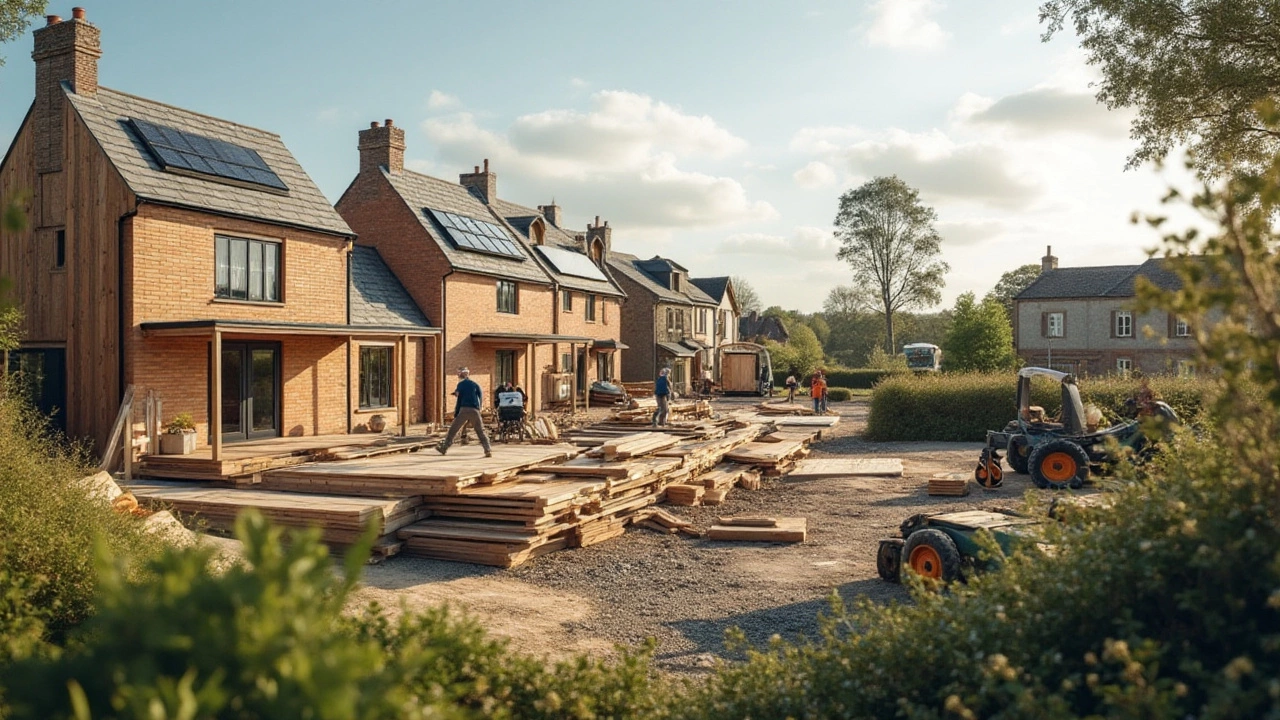Building vs. Buying: Is DIY Home Construction More Affordable in 2024?
 Nov, 15 2024
Nov, 15 2024
The notion of constructing your dream home from scratch has tantalized many with its promise of personalization and tailored comforts. 2024 has introduced intriguing variables into the age-old dilemma of whether to build or buy. With shifts in both the economy and technology, the scales are tipping in unexpected ways. This year, more individuals are weighing the benefits of building new against buying an established property.
Recent advancements have lowered costs and made construction more accessible for a wider range of people. Yet, the decision is far from straightforward, with numerous factors needing thorough consideration. In this comprehensive article, we'll explore the varied elements that influence this choice, providing insights and advice to help you make an informed decision.
- Current Housing Market Trends
- Breaking Down the Cost of Building
- The Pros of Building Your Own Home
- Challenges and Risks to Consider
- Tips for Efficient Construction Budgeting
- Conclusion: Making the Right Choice for You
Current Housing Market Trends
As we find ourselves navigating the housing market landscape of 2024, distinct trends are emerging, shaping the decisions of potential homebuyers. With housing market 2024 being a pivotal term, potential buyers and builders are closely monitoring fluctuations in pricing, availability, and broader economic factors. This year, we've seen material costs stabilizing after several volatile years. The cost of timber, for instance, has experienced a slight deflation, making it more tenable for builders to consider new construction projects without the sting of exorbitant material costs that marked previous years.
Moreover, labor expenses have seen a noteworthy shift. The pandemic-driven labor shortages are slowly easing, paving the way for more viable timelines in construction endeavors. Interestingly, innovations in building costs such as 3D printing and modular construction are gaining traction, reducing not just price tags but build times significantly. These technologies are turning into game-changers, offering sustainable solutions alongside traditional methods. A comment from a leading magazine, The Economist, captured this sentiment perfectly:
"The future of housing leans heavily on innovation, providing affordable means of unifying sustainability with mass construction."
It's also vital to acknowledge that interest rates remain a wild card in this intricate game. The Federal Reserve's actions have a critical impact, and in 2024, rates have shown a tendency to stabilize, albeit at a relatively high mark compared to pre-pandemic levels. This stabilization is cautiously welcomed by those looking into secure investment opportunities in real estate. In many regions, suburban and rural areas continue to see a spike in interest, as remote work culture, bolstered by technological strides, still supports the trend of living outside crowded urban hubs. This trend significantly influences the demand for new builds, as land is generally more available and affordable in these areas, allowing for a feasible exploration of DIY home construction.
To give you a clearer view, here's a snapshot of the trends influencing the current market:
- Stabilization in timber and steel prices.
- Gradual resolution of labor shortages.
- Interest rate stabilization at higher than pre-pandemic percentages.
- Increased interest in suburban and rural properties.
- Rising popularity of modular and 3D printing technologies in housing.
A savvy approach to the dynamic housing conditions of 2024 could unveil a world of opportunities aimed at those willing to research and adapt. Whether navigating the unpredictable labor market, harnessing new technologies, or simply making the best of available financial tools, understanding these trends offers a strong strategic advantage.
Breaking Down the Cost of Building
When it comes to constructing a new home, costs can be a jigsaw puzzle of materials, labor, and unpredictable expenses. The price of building costs includes a variety of components, and understanding them can help you plan better. First, consider land acquisition, which can vary widely based on location. Urban areas tend to be pricier, pushing the cost of a plot beyond basic expectations. Meanwhile, in more rural spots, you might snag a larger piece of land for a fraction. However, don't forget the expenses linked with preparing that land, such as clearing trees, grading, and hookups to municipal utilities.
Next up is labor, which has seen a steady rise in the past few years, driven by a growing shortage of skilled workers. This scarcity has upped the ante on wages, meaning hiring a competent crew can take up a substantial portion of your budget. Keeping a close eye on labor costs throughout the project can save you potential headaches. And then there's materials. Thanks to global supply chain interruptions and the fluctuating prices of commodities like lumber and steel, the cost of construction materials can be volatile. The trend towards eco-friendly materials, while commendable, can also push costs higher if you're not careful about your selections.
Let's look at soft costs, too. These often-sneaky expenses related to design and permitting shouldn't be ignored. Engaging an architect or a design-build firm can provide outstanding results, but it comes with a cost that can often be underestimated. In addition, applications for construction permits can be a lengthy and costly process, varying from locality to locality. Plant these into your financial plan early to avoid surprises during the build.
Innovative Building Methods
Considering innovative building methods might lead to reduced expenses. Modular construction, for instance, leverages factory-built modules assembled on-site. This method has not only grown in popularity but also shown promise in trimming timelines and reducing labor costs. Prefabricated homes are another option where pieces are built in a factory and rapidly assembled on planned sites, a method that benefits from bulk purchasing and minimizes waste.
There's growing interest in 3D printing, which could revolutionize the way we think about home building. As tech enhances, 3D printing can create parts of a home, such as panels or even entire sections, at reduced costs. Though still emerging, it holds potential in creating affordable housing.
"The adoption of cutting-edge technologies such as 3D printing and modular construction has started to reshape and accelerate the housing industry's landscape, offering a path to more affordable housing solutions," remarks the National Association of Home Builders.
Breaking down the costs requires strategic planning and a keen examination of each factor. When these elements are understood and managed, DIY home construction could shift from a daunting challenge to a financially sound investment. However, amid such complexity, being well-researched and prepared can illuminate the path to building your dream nest in today's unpredictable market.

The Pros of Building Your Own Home
One of the most compelling reasons to consider building your own home is the unparalleled level of customization it offers. Imagine the freedom of designing every nook and cranny to your liking, from the floor plan to the fixtures. This allows homeowners to make the most of their personal tastes and lifestyle needs, something you simply can't do with a pre-existing property. Picture having a kitchen that's spacious enough for entertaining or a home office tucked away from household noise, perfectly suited to remote work demands. Custom building ensures that each aspect of your home is as unique as you are, fostering a living environment that truly feels like yours.
Another undeniable advantage is the opportunity to integrate sustainable and energy-efficient technologies. New-construction homes can be fitted with state-of-the-art insulation materials, energy-efficient windows, and cutting-edge HVAC systems. These choices not only reduce your carbon footprint but also offer long-term savings on utility bills. According to a study by the National Association of Home Builders, new homes constructed in recent years consume an average of 20% less energy, providing substantial savings over time. Incorporating solar panels or smart home systems throughout the house can contribute significantly to both sustainability and convenience, enhancing the future resale value of the property.
Moreover, modern building techniques often result in a more durable and low-maintenance structure compared to older homes. Utilizing contemporary materials and construction methods can significantly extend the lifespan of your home, reducing the frequency and cost of repairs. For instance, advanced concrete formulas or composite roofing materials guard against harsh weather, while newer plumbing systems can prevent common household leaks. It's a reassuring prospect for homeowners looking to decrease the headaches and expenses associated with ongoing maintenance.
In many cases, DIY home construction provides a financial advantage due to potentially lower property taxes. Newly constructed homes, especially in less densely populated areas, might initially be taxed lower than older homes in established neighborhoods. This can make a substantial difference in annual costs, though it's essential to verify with local tax regulations, as these can vary greatly. Additionally, building allows you to select a lot and a locale that aligns perfectly with your budget and preferred lifestyle, making it an ideal choice for many seeking peace and affordability simultaneously.
As urban planner Jane Jacobs once said, "Old ideas can sometimes use new buildings. New ideas must use old buildings." Opting for a new build allows you to incorporate innovative designs and technology from the ground up, making your home a reflection of modernity and efficiency.
In the context of the current housing market, where existing homes often come with inflated prices and unexpected costs, embarking on your own construction journey could prove more cost-effective. Engaging with construction professionals early on enables you to plan effectively and avoid surprises. Experienced builders can provide valuable insights into cost-saving measures, material alternatives, and project timelines, ensuring you remain within budget while achieving your dream home vision.
Challenges and Risks to Consider
Embarking on the journey to build your own home brings with it a myriad of exciting opportunities, but it is not without its share of challenges. One of the foremost concerns when considering new builds is navigating the unpredictability of building costs. Market fluctuations mean prices for materials like timber and steel can fluctuate dramatically, potentially throwing entire budgets off course. For example, the cost of essential materials soared earlier this decade, prompting many to reconsider projects mid-way. An essential tip is to secure prices with suppliers early in the process to lock in favorable rates. Additionally, it's wise to budget an extra 10-20% as a contingency for unexpected overages, ensuring financial stability throughout the build.
Among the less tangible challenges is the sheer complexity involved. Construction projects often resemble a symphony of moving parts - from permits to contractors, each element plays a crucial role. Miscommunication or delays in any one area can lead to significant setbacks. This is particularly true when balancing labor shortages that have left many skilled workers in high demand. According to the National Association of Home Builders, the construction industry has experienced a shortage of more than 300,000 skilled tradespeople, affecting timelines and exacerbating costs. Ensuring you have a reliable project manager or taking time to oversee processes personally can mitigate these risks.
Another critical risk involves the unpredictable nature of building a home that fits into the current regulatory environment. Building codes and zoning laws vary widely by location, and what may be permissible in one area isn't always allowed in another. These regulations can affect everything from the size and height of the structure to energy efficiency requirements and eco-friendly building mandates. Staying abreast of these ever-evolving rules is vital to prevent costly legal issues. It's not uncommon to hear stories of halted projects due to permit issues, illustrating the importance of securing all necessary approvals in advance.
"The housing market is as dynamic as ever, and with it, so is the process of constructing new homes. Seeking professional advice early can help sidestep many unforeseen hurdles," suggests James Peterson, an industry veteran and licensed contractor.
Of course, no discussion of challenges would be complete without mentioning the emotional and physical toll such undertakings can have. Building a home, especially one that aligns with personal dreams and visions, is a labor of love that demands patience and resilience. The stress of juggling different aspects, from selecting fixtures to managing workers, can be overwhelming. Taking regular breaks and setting realistic expectations is vital for maintaining both mental health and enthusiasm throughout the project.
Finally, environmental factors present their unique set of risks. Construction projects are often at the mercy of weather conditions. Delays due to rain, wind, or extreme temperatures are not uncommon and can further inflate DIY home construction timelines, disrupting planned schedules. Having flexible plans and setting buffer time for potential delays is a sound strategy. As more builders focus on sustainable practices, considering eco-friendly materials and energy-efficient designs can alleviate some environmental impacts while possibly securing tax incentives.

Tips for Efficient Construction Budgeting
Building a home from the ground up is as much an exercise in managing expenses as it is in choosing designs and materials. To embark on this journey successfully, one must understand the art of construction budgeting. Start by conducting detailed research on current building costs, including labor and materials, which have seen fluctuations due to supply chain issues. With prices varying widely, having a concrete understanding of unit costs can significantly impact your budget strategy. Planning ahead, you might consider consulting with seasoned contractors who can provide realistic estimates and prepare you for unexpected expenditures.
Another essential tip is to prioritize essential features while leaving room for upgrades. Focus on structural needs first, such as a strong foundation and quality insulation, which can save money in the long run through better energy efficiency. It's easy to get swept up in aesthetic choices, but practical elements often yield more significant financial benefits. Think of your spending as a tiered process: essentials at the base, upgradable luxuries at the top.
"Failing to plan is planning to fail. Stick to a detailed budget plan and resist overspending on 'nice-to-haves' until the project is well underway," advises William Jenkins, a renowned builder with over three decades of experience.
Consider incorporating innovative building techniques and materials that may initially cost more but offer savings in the long term. For instance, prefabricated panels can reduce labor hours, indirectly cutting costs. Additionally, sustainable materials, while sometimes pricier upfront, can lead to lower energy bills and maintenance costs. Exploring new technologies like 3D printing can also present cost-effective solutions for certain elements of your new home.
| Expense Category | Estimated Cost |
|---|---|
| Foundation | $20,000 - $40,000 |
| Roofing | $10,000 - $25,000 |
| Electrical & Plumbing | $15,000 - $30,000 |
Don’t underestimate the importance of a contingency fund, generally suggested at about 10-15% of your total budget. Unexpected costs during construction can be surprising, whether they arise from weather delays, material price spikes, or unforeseen site conditions. By maintaining a financial cushion, you'll be better equipped to handle these challenges without jeopardizing the DIY home construction project. In today’s unpredictable market, a flexible approach to cost management is indispensable, aligning closely with your vision and financial reality.
Finally, maintain an open line of communication with your building team. Regular updates and honest discussions can prevent cost overruns and ensure that your input is reflected in the construction process. Transparency from both sides is critical, paving the way for timely adjustments to the plan as needed. Be aware of contract terms and conditions, including payment schedules and penalties to mitigate any financial disputes. This strategic approach can lead to a successful, stress-free project that keeps you within budget while achieving your new home goals.
Conclusion: Making the Right Choice for You
Deciding whether to embark on the journey of constructing a new home or selecting a ready-made option involves more than a simple calculation of dollars and cents. It's an intricate decision influenced by your unique lifestyle aspirations, financial situation, and market conditions. As of 2024, the housing market presents an array of opportunities and challenges. For those with a penchant for personalization, constructing a new home continues to offer unmatched advantages by allowing you to design everything from layout to finishes. However, be prepared for the intricacies involved, from liaising with architects and contractors to navigating building codes and zoning regulations.
The DIY home construction path, although rewarding, is not devoid of its own set of hurdles. Understanding the full range of building costs is crucial as material prices remain unpredictable, largely influenced by both local and global economic shifts. According to a report by the National Association of Home Builders, labor shortages have persisted, potentially increasing the time and expense involved in finishing your new home. On the contrary, buying a home comes with its own stressors, like competitive bidding wars in popular locations and potential for major unseen repairs.
A major advantage in favor of building today lies in the ability to incorporate sustainable technologies from the onset. Energy-efficient systems not only reduce future utility bills but might also increase the home's resale value. A study in 2023 recorded that homes built with green standards sold for 10% more than conventional homes. This makes new builds an enticing proposition for the environmentally conscious investor. Yet, it's essential to conduct a detailed cost analysis to ensure any investment in eco-friendly technologies meets your long-term financial goals.
The U.S. Census Bureau emphasizes that, "In the right market conditions, building can indeed offer more bang for your buck, especially in expanding suburbs." This rings particularly true for growing families or those seeking custom features not typically found in older homes.
Your ultimate choice should align with your current circumstances, both personally and financially. For those keen on the process of creation and customization, the evolving landscape of new home costs offers creative freedom and potentially greater financial returns in the long run. Conversely, those who value immediacy and convenience might find existing homes appealing, especially if time is of the essence. Considering all these aspects will guide you to a decision that matches your vision and circumstances, ensuring that whether you build or buy, your future home is a place of comfort and happiness.
